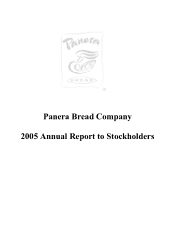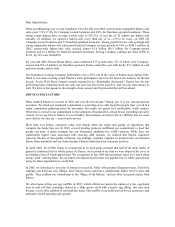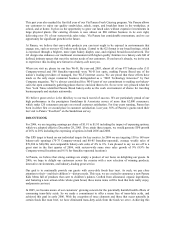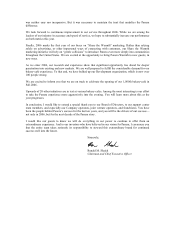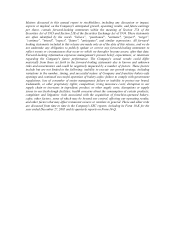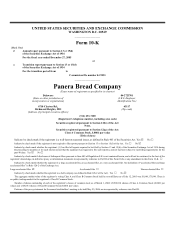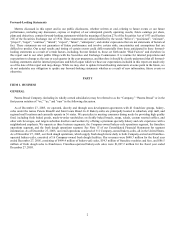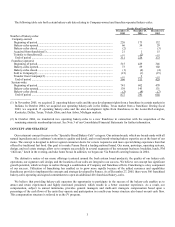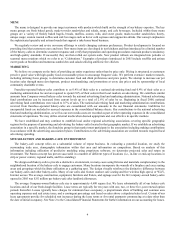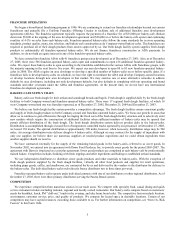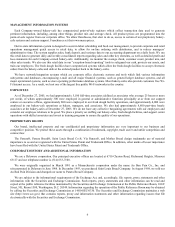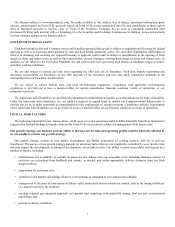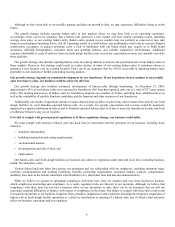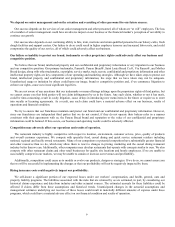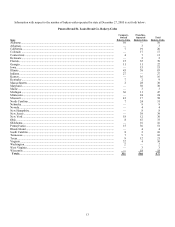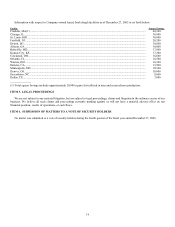Panera Bread 2005 Annual Report Download - page 10
Download and view the complete annual report
Please find page 10 of the 2005 Panera Bread annual report below. You can navigate through the pages in the report by either clicking on the pages listed below, or by using the keyword search tool below to find specific information within the annual report. 4
MENU
The menu is designed to provide our target customers with products which build on the strength of our bakery expertise. The key
menu groups are fresh baked goods, made-to-order sandwiches and salads, soups, and cafe beverages. Included within these menu
groups are a variety of freshly baked bagels, breads, muffins, scones, rolls, and sweet goods; made-to-order sandwiches; hearty,
unique soups; custom roasted coffees and cafe beverages such as hot or cold espresso and cappuccino drinks. Our concept emphasizes
the sophisticated specialty and artisan breads that support a take-home bread business.
We regularly review and revise our menu offerings to satisfy changing customer preferences. Product development is focused on
providing food that customers crave and trust. New menu items are developed in test kitchens and then introduced in a limited number
of the bakery-cafes to determine customer response and verify that preparation and operating procedures maintain product consistency
and high quality standards. If successful, they are then rolled out system-wide. New product rollouts are integrated into periodic or
seasonal menu rotations which we refer to as “Celebrations.” Examples of products introduced in 2005 include soufflés and artisan
sweet goods at breakfast and numerous sandwiches and salads utilizing antibiotic free chicken.
MARKETING
We believe we compete on the basis of providing an entire experience rather than by price only. Pricing is structured so customers
perceive good value with high quality food at reasonable prices to encourage frequent visits. We perform extensive market research,
including utilizing focus groups, to determine customer food and drink preferences and price points. We attempt to increase our per
location sales through menu development, product merchandising, and promotions at every day prices and by sponsorship of local
community charitable events.
Franchise-operated bakery-cafes contribute to us 0.4% of their sales to a national advertising fund and 0.4% of their sales as a
marketing administration fee and are required to spend 2.0% of their sales in their local markets on advertising. We contribute similar
amounts from Company-owned bakery-cafes towards the national advertising fund and marketing administration. National advertising
fund contributions can be increased from current levels up to a total of 2.6% of sales by us. Beginning in fiscal 2006, national
advertising fund contributions were raised to 0.7% of sales. The national advertising fund and marketing administration contributions
received from franchise-operated bakery-cafes are consolidated with our amounts in the our financial statements. Liabilities for
unexpended funds are included in accrued expenses in the consolidated balance sheets. Our contributions to the national advertising
fund and marketing administration, as well as our own media costs are recorded as part of other operating expenses in the consolidated
statements of operations. We may utilize external media when deemed appropriate and cost effective in specific markets.
We have established and may continue to establish local and/or regional advertising associations covering specific geographic
regions for the purpose of promoting and advertising the bakery-cafes located in that geographic market. If we establish an advertising
association in a specific market, the franchise group in that market must participate in the association including making contributions
in accordance with the advertising association bylaws. Contributions to the advertising association are credited towards required local
advertising spending.
SITE SELECTION AND BAKERY-CAFE ENVIRONMENT
The bakery-cafe concept relies on a substantial volume of repeat business. In evaluating a potential location, we study the
surrounding trade area, demographic information within that area and information on competitors. Based on analysis of this
information including utilization of predictive modeling using proprietary software, we determine projected sales and return on
investment. The Panera concept has proven successful in a number of different types of locations (i.e., in-line or end-cap locations in
strip or power centers, regional malls, and free-standing).
We design each bakery-cafe to provide a distinctive environment, in many cases using fixtures and materials complementary to the
neighborhood location of the bakery-cafe to engage customers. Many locations incorporate the warmth of a fireplace and cozy seating
areas and groupings which facilitate utilization as a gathering spot. The design visually reinforces the distinctive difference between
our bakery-cafes and other bakery-cafes. Many of our cafes also feature outdoor cafe seating and free wireless high speed, or Wi-Fi,
Internet access. The average construction, equipment, furniture and fixture, and signage cost for the 66 Company-owned bakery-cafes
opened in 2005 was $.92 million per bakery-cafe after landlord allowances.
The average Company-owned bakery-cafe size is approximately 4,600 square feet. We lease substantially all of our bakery-cafe
locations and all of our fresh dough facilities. Lease terms are typically for ten years with one, two, or three five-year renewal option
periods thereafter. Leases typically have charges for minimum base occupancy, a proportionate share of building and common area
operating expenses and real estate taxes, and a contingent percentage rent based on sales above a stipulated sales level. Certain of our
lease agreements provide for scheduled rent increases during the lease terms or for rental payments commencing at a date other than
the date of initial occupancy. See Note 2 to the Consolidated Financial Statements for further information on our accounting for leases.

